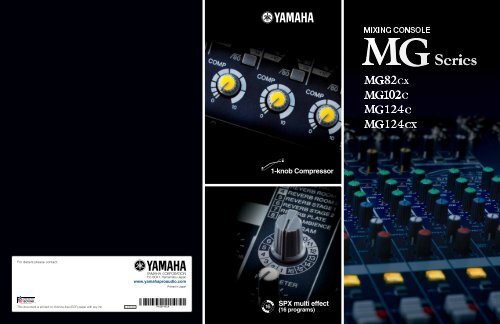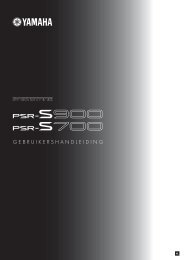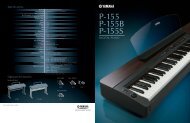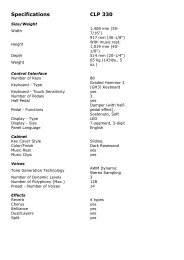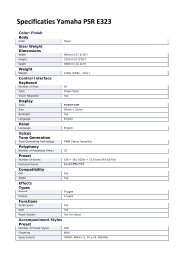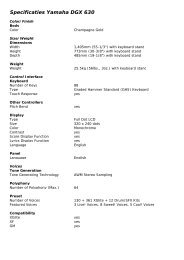1-knob Compressor SPX multi effect - Clavis Piano's
1-knob Compressor SPX multi effect - Clavis Piano's
1-knob Compressor SPX multi effect - Clavis Piano's
Create successful ePaper yourself
Turn your PDF publications into a flip-book with our unique Google optimized e-Paper software.
For details please contact:<br />
LPA530<br />
www.yamahaproaudio.com<br />
Printed in Japan<br />
1-<strong>knob</strong> <strong>Compressor</strong><br />
<strong>SPX</strong> <strong>multi</strong> <strong>effect</strong><br />
(16 programs)
MG SERIES INTRODUCTION APPLICATION EXAMPLES SOUND ADVICE<br />
Small Mixers<br />
with Serious Performance Application Examples<br />
Whether you’re only mixing one microphone with a<br />
stereo source for the web, or <strong>multi</strong>ple microphones<br />
and line sources for a live show, you want the highest<br />
performance, flexibility, and reliability available.<br />
Yamaha’s MG-series mixers cover a wide range of<br />
applications from solo home recording to complex live<br />
sound with no compromises in sonic quality,<br />
processing versatility, or dependability.<br />
The new additions to the MG series introduced in this<br />
brochure feature the same compact, lightweight design as<br />
the preceding models, and incorporate the latest<br />
generation of specially-selected components for<br />
further refined performance and audio precision.<br />
They also now feature Yamaha’s innovative<br />
one-<strong>knob</strong> compressor for built-in dynamics<br />
control that further eliminates the need for external<br />
equipment and potentially troublesome connections.<br />
If you need a convenient analog mixer that can handle<br />
from 8 and 12 input sources and deliver pro-level sound,<br />
plus top-quality <strong>SPX</strong> <strong>effect</strong>s in the “CX” models, you’re<br />
looking in the right place.<br />
Home Recording<br />
This exceptionally simple system may be all you need<br />
for practice and basic recording at home.<br />
An electric-acoustic guitar and microphone are<br />
plugged directly into the channel inputs of an<br />
MG82CX, while a CD player is connected to the 2TR<br />
line inputs for convenient play-along practice. The<br />
MG82CX’s channel compressors and internal <strong>effect</strong>s<br />
provide plenty of signal processing capability.<br />
The REC OUT jacks could be connected to a recorder<br />
or computer for basic recording functionality.<br />
A pair of headphones is used for monitoring.<br />
Band Rehearsal/Performance<br />
This live-sound system uses an<br />
MG124CX to handle a main<br />
vocal microphone plus three<br />
chorus microphones, plus a<br />
synthesizer and electronic piano.<br />
A pair of MSR400 powered<br />
speakers are used for main<br />
output, while an MSR100<br />
powered speaker serves as a<br />
monitor for the performers.<br />
The built-in channel<br />
compressors and <strong>effect</strong>s<br />
eliminate the need for any<br />
outboard signal processing gear.<br />
Sound Advice<br />
Electric Guitar<br />
Mics<br />
Mic<br />
Electric-Acoustic<br />
Guitar<br />
Line Driver<br />
Electric Bass Direct Box<br />
MO6<br />
CP300<br />
CD player<br />
In both of the systems described above, and in many other applications, the<br />
built-in channel compressors provided on the new MG mixers can<br />
significantly enhance the quality of your mixes. If you’re mixing vocals, that<br />
will be the first place you’ll want to try some compression. Singers often<br />
employ a very wide dynamic range, going from a barely audible whisper to<br />
an ear-popping shout. And there are unintentional level variations that can<br />
be caused by variations in microphone distance and pickup angle. Without<br />
compression the vocal is likely to be buried in the music at some points, and<br />
then totally overpower it at others. You can reduce the problem by<br />
continuously “riding the gain” manually, but it isn’t easy, and means that<br />
XLR (female)<br />
TRS Pnone<br />
TRS Phone<br />
MG124CX<br />
XLR (male)<br />
XLR (male)<br />
TRS Phone<br />
MG82CX<br />
RCA Pin<br />
RCA Pin<br />
MSP5 STUDIO<br />
MSP5 STUDIO<br />
MSR400<br />
MSR400<br />
MSR100 MSR100<br />
someone has to be at the mixer at all times. The right amount of<br />
compression can solve the problem precisely and automatically. The<br />
problem with conventional compressors is that achieving “the right amount<br />
of compression” means setting a number of parameters to match the source.<br />
It can be tricky. The channel compressors on the new MG mixers, however,<br />
only require you to set one simple control. All you have to do is rotate the<br />
COMP <strong>knob</strong> until things sound right, and you’re ready to roll! The MG mixer<br />
one-<strong>knob</strong> compressor covers a fairly wide range, from subtle compression to<br />
almost a distorted type of sound, so use your ears and musical sense to set it<br />
for the best overall sound with the mix you’re trying to achieve.
MG SERIES MG802CX MG802CX<br />
Small but Sophisticated<br />
Many real-world mixing applications only involve a few channels, so a small mixer is the obvious choice. But no matter how simple the setup, you’ll always<br />
want first-rate audio quality and processing capability. The MG82CX and MG102C are the ideal choice for small music production or live sound<br />
applications, offering sonic quality that will satisfy the most critical listener, surprising flexibility and ease-of-use, and some advanced features you normally<br />
wouldn’t find in this type of compact mixer. So whether you need a compact main mixer, or a secondary utility mixer for a larger application, don’t<br />
overlook these performance-packed models.<br />
INPUTS & CHANNELS<br />
Flexible 8 or 10 Input Channel Configurations<br />
The MG82CX has a total of 8 input channels comprised of<br />
two mono microphone/line channels and three stereo line<br />
channels. The MG102C has an addition stereo channel for a<br />
total of 10 input channels. On both models two of the stereo<br />
channel can be used as mono microphone inputs, providing<br />
a total of four microphone inputs when necessary. Gain trim<br />
covers a wide -60dB ~ -16dB range for microphone input,<br />
and -34dB ~ +10dB for line input.<br />
Comprehensive, Easy-access Connector Panel<br />
Top-mounted input and<br />
output connectors make<br />
setting up and re-patching<br />
your system quick and<br />
easy. Both models feature<br />
high-quality Neutrik<br />
balanced XLR connectors<br />
on both mono<br />
microphone/line channels<br />
and two of the stereo channels. The XLR-equipped stereo<br />
channels can accept mono microphone input either via the<br />
XLR or phone jack connectors. The remaining stereo<br />
channel on the MG82CX and the remaining two stereo<br />
channels on the MG102C provide phone jack and pin jack<br />
connectors for compatibility with a wide range of sources.<br />
The two mono input channels also feature insert I/O<br />
connectors that let you patch external signal processing<br />
gear into those channels as required. Separate pin-jack 2TR<br />
inputs are provided to accept the output from a CD player or<br />
similar stereo source.<br />
Four High-performance Microphone<br />
Preamplifiers with Switchable Phantom Power<br />
Microphone preamplifiers are critical in any mixer, and a<br />
performance bottleneck in many. That’s why pros often<br />
spend thousands of dollars on just a single channel of<br />
microphone pre-amplification. The microphone preamps<br />
built into the MG mixers inherit technology from Yamaha’s<br />
top-line professional consoles, and have been painstakingly<br />
designed to deliver superior sonic performance with any<br />
dynamic or condenser microphone. All four microphone<br />
preamps also feature switchable phantom power so you can<br />
take advantage of the natural, extended response of highquality<br />
condenser microphones. A single switch turns<br />
phantom power on or off for all four channels.<br />
Built-in Channel <strong>Compressor</strong>s<br />
This advanced feature can be a tremendous advantage in<br />
achieving great vocal sound. It can also be used to refine the<br />
sound of bass, guitar, and other sources. You won’t find<br />
built-in channel compression on too many other mixers in<br />
this class, but in the MG82CX and MG102C you have<br />
Yamaha’s innovative one-<strong>knob</strong> compression feature on<br />
mono input channels 1 and 2. Conventional audio<br />
compressors with their threshold, ratio, knee, makeup gain<br />
and other controls can be complex and time-consuming to<br />
set appropriately for a given source. Yamaha’s one-<strong>knob</strong><br />
compressor eliminates the need for an engineering degree<br />
with a single control that lets you simply dial in the amount<br />
of compression you want.<br />
3-band Channel EQ and High-pass Filter<br />
Building a truly useful, musical-sounding channel equalizer is<br />
no easy task, but Yamaha has decades of experience in<br />
building pro consoles to draw on, and you reap the benefits<br />
in the MG-series mixers. Channels 1, 2, 3/4, and 5/6 feature<br />
full 3-band equalizers with LOW, MID, and HIGH controls,<br />
while channel 7/8 on the MG82CX and channels 7/8 and 9/10<br />
have 2-band EQ for smooth equalization of stereo sources.<br />
MASTER & OUTPUT<br />
SECTION<br />
Effect/Aux Sends<br />
The MG82CX has EFFECT send controls on all channels that<br />
adjust the level of the signal sent from the corresponding<br />
channel to the mixer’s internal <strong>multi</strong>-<strong>effect</strong> system. The<br />
same signal can also be sent to external <strong>effect</strong> processors<br />
via the mixer’s EFFECT SEND jack. The MG102C has AUX<br />
send controls on all channels in place of the MG82CX<br />
EFFECT send controls, and these adjust the level of the<br />
signal sent from the corresponding channel to the AUX<br />
SEND jack that can be used to feed external <strong>effect</strong>s or a<br />
monitor system. A RETURN control in the master section of<br />
both models adjusts the level of the signal returned from<br />
external processors via the RETURN jacks.<br />
Stereo, Control Room, Monitor,<br />
and Headphone Outputs<br />
Located above the mixer’s<br />
master controls, on the<br />
convenient easy-access<br />
connector panel, are the main<br />
stereo output connectors,<br />
phone-jack monitor output<br />
connectors, pin-jack recording outputs, and a stereo<br />
headphone jack. They may be compact, but these mixers offer<br />
plenty of connectivity for a wide range of applications.<br />
Bright Meters for Visual Level Monitoring<br />
Accurate visual level monitoring can help you achieve<br />
maximum signal-to-noise ratio without distortion. The MG<br />
mixer’s bright, easy-to-read <strong>multi</strong>-segment LED meters<br />
make it easy to control system levels for optimum overall<br />
performance.<br />
MG82CX Built-in <strong>SPX</strong> Effects<br />
There’s an astonishing amount of <strong>SPX</strong><br />
signal processing power packed into<br />
the MG82CX’s diminutive chassis.<br />
It incorporates a versatile digital<br />
<strong>multi</strong>-<strong>effect</strong> processor that provides a<br />
range of reverb, delay, modulation,<br />
and distortion programs you can use<br />
to refine and define your sound.<br />
Each of the 16 <strong>effect</strong> programs has a<br />
number of editable parameters as<br />
well as <strong>effect</strong> on/off switching<br />
capability and return level control.<br />
If you need to keep both hands free<br />
to play an instrument or perform<br />
other operations, an optional<br />
footswitch can be connected to the<br />
mixer’s <strong>effect</strong> footswitch jack for<br />
convenient on/off switching.<br />
UNMATCHED EASE &<br />
CONVENIENCE<br />
Lightweight, Portable Design<br />
The MG82CX and MG102C weigh only 1.6 and 1.5<br />
kilograms, respectively. That’s small enough to pop into<br />
your briefcase or shoulder bag<br />
and easily take with you<br />
anywhere. But the performance<br />
you’ll get at the studio, club,<br />
outdoors, or anywhere you<br />
choose to use these fine mixers<br />
is far from lightweight.<br />
Optional Mic Stand Mount<br />
Both of these compact models<br />
can be mounted on a microphone<br />
stand for optimal positioning and<br />
easy access using the optional<br />
BMS-10A Mic Stand Adaptor. This<br />
can be particularly handy when<br />
using the mixer as sub-mixer for<br />
drums or as a cue box in<br />
recording situations.<br />
Easy Operation<br />
All switches, controls, and displays have been designed and laid<br />
out for intuitive access and smooth, reliable operation with<br />
positive tactile and visual feedback.<br />
Digital Effect Program List<br />
No Program<br />
1 REVERB HALL 1<br />
2 REVERB HALL 2<br />
3 REVERB ROOM 1<br />
4 REVERB ROOM 2<br />
5 REVERB STAGE 1<br />
6 REVERB STAGE 2<br />
7 REVERB PLATER<br />
8 DRUM AMBIENCE<br />
OPTIONS<br />
Foot Switch<br />
FC-5<br />
for MG82CX<br />
DIMENSIONS<br />
No Program<br />
9 KARAOKE ECHO<br />
10 VOCAL ECHO<br />
11 CHORUS 1<br />
12 CHORUS 2<br />
13 FLANGER<br />
14 PHASER<br />
15 AUTO WAH<br />
16 DISTORTION<br />
Mic Stand Adapter<br />
BMS10-A<br />
for MG82CX, MG102C<br />
256.6 62.2<br />
302.5<br />
Unit: mm
MG SERIES MG124C MG124CX<br />
Extended Capacity and Versatility for Studio or Stage<br />
For applications requiring up to 12 input channels the MG124C or MG124CX offer stunning MG-series sound plus an extra margin of signal-routing versatility.<br />
The only difference is <strong>effect</strong>s. If you don’t need <strong>effect</strong>s or already have a collection of outboard <strong>effect</strong>s that suit your needs, the MG124C is probably the right choice.<br />
The MG124CX features a high-performance digital <strong>multi</strong>-<strong>effect</strong> processor built-in, giving you everything you need in one compact, powerful package.<br />
INPUTS & CHANNELS<br />
Flexible 12-input Configuration<br />
The MG124C and MG124CX both have a total of 12 input<br />
channels - four mono microphone/line inputs and four stereo<br />
line inputs. Two of the stereo line inputs can also function as<br />
mono microphone inputs, giving you up to six simultaneous<br />
mono microphone inputs when needed. Gain trim covers a wide<br />
-60dB ~ -16dB range for microphone input, and -34dB ~<br />
+10dB for line input.<br />
Comprehensive, Easy-access Connector Panel<br />
Top-mounted input and<br />
output connectors make<br />
setting up and re-patching<br />
your system quick and easy.<br />
Both models feature highquality<br />
Neutrik balanced<br />
XLR connectors on all four<br />
mono microphone/line<br />
channels and two of the<br />
stereo channels. The XLR-equipped stereo channels can accept<br />
mono microphone input either via the XLR or phone jack<br />
connectors. The remaining stereo channels provide phone jack<br />
and pin jack connectors for compatibility with a wide range of<br />
sources. The four mono input channels also feature insert I/O<br />
connectors that let you patch external signal processing gear<br />
into those channels as required. Separate pin-jack 2TR inputs<br />
are provided to accept the output from a CD player or similar<br />
stereo source.<br />
Six High-performance Microphone<br />
Preamplifiers with Switchable Phantom Power<br />
The microphone preamplifiers in any mixer are critical to its<br />
overall performance. The microphone preamps built into the<br />
MG mixers inherit technology from Yamaha’s top-line<br />
professional consoles, and have been painstakingly designed to<br />
deliver superior sonic performance with any dynamic or<br />
condenser microphone. All six microphone preamps feature<br />
switchable phantom power so you can take advantage of the<br />
natural, extended response of high-quality condenser<br />
microphones. A single switch turns phantom power on or off for<br />
all microphone channels.<br />
Built-in Channel <strong>Compressor</strong>s<br />
Built-in channel dynamics is usually only found on high-end<br />
(and very expensive) consoles. The MG124C and MG124CX<br />
feature Yamaha’s innovative one-<strong>knob</strong> compression feature on<br />
mono input channels 1 through 4. This advanced feature can be<br />
a tremendous advantage in achieving great vocal sound. It can<br />
also be used to refine the sound of bass, guitar, and other<br />
sources. Conventional audio compressors with their threshold,<br />
ratio, knee, makeup gain and other controls can be complex<br />
and time-consuming to set appropriately for a given source.<br />
Yamaha’s one-<strong>knob</strong> compressor eliminates the need for an<br />
engineering degree with a single control that lets you simply dial<br />
in the amount of compression you want.<br />
3-band Channel EQ and High-pass Filter<br />
Yamaha has decades of experience in building truly useful,<br />
musical equalization into successful pro consoles, and the<br />
channel equalizers in MG-series mixers carry on without<br />
compromise. Channels 1, 2, 3, 4, 5/6, and 7/8 feature full<br />
3-band equalizers with LOW, MID, and HIGH controls, while<br />
9/10 and 11/12 have 2-band EQ for smooth equalization of<br />
stereo sources.<br />
Four Buses (Stereo and Group)<br />
In addition to the main stereo bus the MG124C and MG124CX<br />
feature a stereo group bus and outputs that can be used for<br />
convenient channel grouping. Assign switches for the stereo and<br />
group buses are located next to each channel fader.<br />
Illuminated Channel ON Switches<br />
All input channels feature illuminated channel<br />
ON switches chat can be used to individually add<br />
or remove channels from the mix without having<br />
to change the positions of the channel faders.<br />
The <strong>effect</strong> channel on the MG124CX also has it’s<br />
own ON switch.<br />
MASTER & OUTPUT<br />
SECTION<br />
Effect/Aux Sends<br />
The MG124CX has pre/post switchable AUX sends on all<br />
channels as well as EFFECT send controls that adjust the level of<br />
the signal sent to the mixer’s internal <strong>multi</strong>-<strong>effect</strong> system. The<br />
MG124C has dual AUX send controls for each channel, one<br />
switchable for pre- or post-fader operation, and one fixed for prefader<br />
send. Master send controls are also provided, as are RETURN<br />
level controls for the AUX and STEREO busses.<br />
Stereo, Control Room, Monitor,<br />
and Headphone Outputs<br />
Located above the mixer’s<br />
master controls, on the<br />
convenient easy-access<br />
connector panel, are the<br />
main stereo output<br />
connectors, phone-jack<br />
monitor output connectors, pin-jack recording outputs, and a<br />
stereo headphone jack. These versatile mixers offer plenty of<br />
connectivity for a wide range of applications.<br />
Bright 12-segment Meters for<br />
Visual Level Monitoring<br />
Accurate visual level monitoring can help you<br />
achieve maximum signal-to-noise ratio without<br />
distortion. The MG mixer’s bright, easy-to-read<br />
12-segment LED meters make it easy to control<br />
system levels for optimum overall performance.<br />
MG124CX Built-in <strong>SPX</strong> Effects<br />
The MG124CX’s includes an astonishing<br />
amount of <strong>SPX</strong> signal processing power.<br />
It incorporates a versatile digital<br />
<strong>multi</strong>-<strong>effect</strong> processor that provides a<br />
range of reverb, delay, modulation,<br />
and distortion programs you can use<br />
to refine and define your sound.<br />
Each of the 16 <strong>effect</strong> programs has a<br />
number of editable parameters as<br />
well as <strong>effect</strong> on/off switching<br />
capability and return level control.<br />
If you need to keep both hands free<br />
to play an instrument or perform<br />
other operations, an optional<br />
footswitch can be connected to the<br />
mixer’s <strong>effect</strong> footswitch jack for<br />
convenient on/off switching.<br />
UNMATCHED EASE &<br />
CONVENIENCE<br />
Smooth 60-millimeter Faders<br />
Channel and master level control is accomplished via<br />
reliable, high-performance 60-millimeter linear faders that<br />
provide smooth,<br />
noise-free operation.<br />
An important advantage<br />
of linear faders is that<br />
they provide a direct<br />
visual indication of<br />
relative level settings.<br />
Lightweight, Portable Design<br />
In spite of the fact that they offer 12 channels, four buses,<br />
and a wealth of advanced features, the MG124C and<br />
MG124CX are small and light<br />
enough (only 2.9 kilograms) to<br />
be tucked under an arm and set<br />
up just about anywhere. Both of<br />
these remarkable mixers<br />
provide significant space<br />
savings along with huge<br />
performance benefits.<br />
Easy Operation<br />
All switches, controls, and displays have been designed and laid<br />
out for intuitive access and smooth, reliable operation with<br />
positive tactile and visual feedback.<br />
Digital Effect Program List<br />
No Program<br />
1 REVERB HALL 1<br />
2 REVERB HALL 2<br />
3 REVERB ROOM 1<br />
4 REVERB ROOM 2<br />
5 REVERB STAGE 1<br />
6 REVERB STAGE 2<br />
7 REVERB PLATER<br />
8 DRUM AMBIENCE<br />
OPTIONS<br />
DIMENSIONS<br />
No Program<br />
9 KARAOKE ECHO<br />
10 VOCAL ECHO<br />
11 CHORUS 1<br />
12 CHORUS 2<br />
13 FLANGER<br />
14 PHASER<br />
15 AUTO WAH<br />
16 DISTORTION<br />
Foot Switch<br />
FC-5<br />
for MG124CX<br />
346.2 86.1<br />
436.6<br />
Unit: mm
MG SERIES SPECIFICATIONS<br />
MG82CX, MG102C Specifications MG124C, MG124CX Specifications<br />
General Specifications General Specifications<br />
Frequency Response STEREO OUT<br />
EFFECT SEND<br />
(AUX SEND*)<br />
MONITOR OUT, REC OUT<br />
Total Harmonic Distortion STEREO OUT +14 dBu, 20 Hz – 20 kHz, Input Gain Control<br />
(THD + N) at minimum<br />
Hum & Noise Input: CH INPUT 1, 2 MIC EIN (Equivalent Input Noise): Rs = 150 Ω,<br />
Hum & Noise are measured<br />
GAIN: maximum (CH 1, 2)<br />
with a 6 dB/octave filter STEREO OUT STEREO Master control at nominal level<br />
@12.7 kHz; equivalent to<br />
and all CH Level control at minimum.<br />
a 20 kHz filter with infinite<br />
dB/octave attenuation.<br />
EFFECT SEND<br />
(AUX SEND*)<br />
All CH EFFECT (AUX*) controls at minimum.<br />
STEREO OUT STEREO Master control and one CH level control<br />
at nominal level (CH1, 2)<br />
-3.0 – 1.0 dB<br />
0.1% dBu<br />
-128 dBu<br />
-87 dBu<br />
-85 dBu<br />
-64 dBu<br />
STEREO OUT Residual Output Noise -100 dBu<br />
Crosstalk (1 kHz) Adjacent Input CH 1, 2 -70 dB<br />
Input to Output STEREO L/R, CH 1, 2, PAN: panned hard left or right -70 dB<br />
Phantom Voltage MIC + 48 V<br />
Input HPF CH 1-5/6, 80 Hz, 12 dB/oct<br />
Input Equalization CH 1-5/6 HIGH: 10 kHz (shelving)<br />
Turn over/roll-off frequency<br />
of shelving: 3 dB below<br />
maximum variable level.<br />
+15, -15dB maximum.<br />
MID: 2.5 kHz (peaking)<br />
LOW: 100 Hz (shelving)<br />
CH 7/8 (CH 7/8, 9/10*) HIGH: 10 kHz (shelving)<br />
LOW: 100 Hz (shelving)<br />
PEAK Indicator Red LED turns on when post EQ signal (either post MIC HA or post EQ signal<br />
for CH 3/4, 5/6) reaches –3 dB below clipping (+17 dBu).<br />
Internal Digital Effect* 16 PROGRAM, PARAMETER control<br />
Foot Switch (Digital Effect On/Off)<br />
LED Level Meter Pre MONITOR Level 2 x 7 points LED meter (PEAK, +6, +3, 0, -5, -10, -20 dB)<br />
PEAK lights if the signal level reaches 3 dB below the clipping level.<br />
Power Supply Adaptor PA-10 AC 38 VCT, 0.62 A, Cable Length = 3.6 m<br />
Power Consumption 21 W<br />
GAIN: min (CH 1-5/6)<br />
20 Hz – 20 kHz<br />
Nominal output level @1 kHz<br />
Dimensions (W x H x D) 256.6 mm x 62.2 mm x 302.5 mm<br />
Net Weight 1.6 kg (MG82CX), 1.5 kg (MG102C)<br />
All level controls are nominal if not specified.<br />
Output impedance of signal generator: 150 Ω<br />
*The MG82CX feature is described first, followed by the MG102C feature in brackets: MG82CX (MG102C)<br />
Frequency Response STEREO OUT<br />
GROUP OUT<br />
EFFECT/AUX<br />
(AUX1, 2*) SEND<br />
MONITOR OUT, REC OUT<br />
Total Harmonic Distortion STEREO OUT +14 dBu @ 20 Hz-20 kHz<br />
(THD + N) Input GAIN Control at minimum<br />
Hum & Noise<br />
Hum & Noise are measured<br />
with a 6 dB/octave filter<br />
@ 12.7 kHz; equivalent to<br />
a 20 kHz filter with infinite<br />
dB/octave attenuation.<br />
CH INPUT 1-4 MIC<br />
EIN (Equivalent Input Noise): Rs = 150 Ω,<br />
GAIN: maximum<br />
STEREO OUT STEREO OUT, GROUP Master fader at nominal<br />
GROUP OUT level and all channels’ ST and 1-2 switches off.<br />
EFFECT/AUX Master EFFECT/AUX (AUX1, 2) control at nominal level<br />
(AUX1, 2*) SEND and all CH EFFECT/AUX (AUX1, 2) controls at minimum.<br />
-3.0 – 1.0 dB<br />
0.1%<br />
-128 dBu<br />
-88 dBu<br />
-81 dBu<br />
STEREO OUT<br />
GROUP OUT<br />
STEREO, GROUP Master fader and one CH fader<br />
at nominal level.<br />
-64 dBu<br />
STEREO OUT Residual Output Noise -98 dB<br />
Crosstalk (1 kHz) Adjacent Input CH 1-4 -70 dB<br />
Input to Output STEREO L/R, CH 1-4, PAN: panned hard left or right -70 dB<br />
Phantom Voltage MIC + 48V<br />
Input HPF CH 1-7/8, 80 Hz, 12 dB/oct<br />
Input equalization CH 1-7/8 HIGH: 10 kHz (shelving)<br />
Turn over/roll-off frequency<br />
of shelving: 3 dB below<br />
maximum variable level.<br />
+15, -15dB maximum.<br />
MID: 2.5 kHz (peaking)<br />
LOW: 100 Hz (shelving)<br />
CH 9/10-11/12 HIGH: 10 kHz (shelving)<br />
LOW: 100 Hz (shelving)<br />
PEAK Indicator Red LED turns on when post EQ signal (either post MIC HA or post EQ signal<br />
for CH 5/6, 7/8) reaches -3 dB below clipping (+17 dBu).<br />
Internal Digital Effect* 16 PROGRAM, PARAMETER control<br />
Foot Switch (Digital Effect On/Off)<br />
LED Level Meter Pre MONITOR Level 2 x 12 points LED meter (PEAK, +10, +6, +3, 0, -3, -6, -10, -15, -20, -25, -30 dB)<br />
PEAK lights if the signal level reaches 3 dB below the clipping level.<br />
Power Supply Adaptor PA-20 AC 35 VCT, 0.94 A, Cable Length = 3.6 m<br />
Power Consumption 30 W<br />
GAIN: min (CH 1-7/8)<br />
20 Hz-20 kHz<br />
Nominal output level @1 kHz<br />
Input: CH 1 to 11/12, RETURN, 2TR IN<br />
Dimensions (W x H x D) 346.2 mm x 86.1 mm x 436.6 mm<br />
Net Weight 3.2 kg (MG124CX), 3 kg (MG124C)<br />
All faders are nominal if not specified.<br />
Output impedance of signal generator: 150 Ω<br />
*The MG124CX feature is described first, followed by the MG124C feature in brackets: MG124CX (MG124C)<br />
Specifications and appearance suject to change without notice.<br />
All trademarks and registered trademarks are property of their respective owners.
MG SERIES INPUT/OUTPUT CHARACTERISTICS BLOCK AND LEVEL DIAGRAM<br />
MG82CX, MG102C Input Characteristics<br />
Connections<br />
Gain<br />
Trim<br />
Actual Load<br />
Impedance<br />
For Use With<br />
Nominal Sensitivity *2<br />
Input level<br />
Nominal Max. before clip<br />
Connector<br />
CH INPUT MIC<br />
(1, 2)<br />
–60 dB<br />
–16 dB<br />
3 kΩ 50–600 Mics<br />
–72 dBu (0.195 mV)<br />
–28 dBu (30.8 mV)<br />
–60 dBu (0.775 mV)<br />
–16 dBu (123 mV)<br />
–40 dBu (7.75 mV)<br />
+4 dBu (1.23V)<br />
XLR-3-31 type *3<br />
CH INPUT LINE<br />
(1, 2)<br />
–34 dB<br />
+10 dB<br />
10 kΩ 600 Lines<br />
–46 dBu (3.88 mV)<br />
– 2 dBu (0.615 V)<br />
–34 dBu (15.5 mV)<br />
+10 dBu (2.45 V)<br />
–14 dBu (155 mV)<br />
+30 dBu (24.5 V)<br />
TRS Phone Jack *4<br />
ST CH MIC INPUT<br />
(3/4, 5/6)<br />
–60 dB<br />
–16 dB<br />
3 kΩ 50–600 Mics<br />
–72 dBu (0.195 mV)<br />
–28 dBu (30.8 mV)<br />
–60 dBu (0.775 mV)<br />
–16 dBu (123 mV)<br />
–40 dBu (7.75 mV)<br />
–6 dBu (389 mV)<br />
XLR-3-31 type *3<br />
ST CH LINE INPUT<br />
(3/4, 5/6)<br />
–34 dB<br />
+10 dB<br />
10 kΩ 600 Lines<br />
–46 dBu (3.88 mV)<br />
– 2 dBu (0.615 V)<br />
–34 dBu (15.5 mV)<br />
+10 dBu (2.45 V)<br />
–14 dBu (155 mV)<br />
+30 dBu (24.5V)<br />
Phone Jack *5<br />
ST CH INPUT<br />
(7/8, 9/10 *7)<br />
— 10 kΩ 600 Lines –22 dBu (61.5 mV) –10 dBu (245 mV) +10 dBu (2.45 V)<br />
Phone Jack *5<br />
RCA Pin Jack<br />
CH INSERT IN (1, 2) — 10 kΩ 600 Lines –12 dBu (195 mV) 0 dBu (0.775 V) +20 dBu (7.75 V) Phone Jack (TRS) *6<br />
RETURN (L, R) — 10 kΩ 600 Lines – 8 dBu (308 mV) +4 dBu (1.23 V) +24 dBu (12.3 V) Phone Jack *5<br />
2TR IN (L, R) — 10 kΩ 600 Lines –22 dBV (79.4 mV) –10 dBV (0.316 V) +10 dBV (3.16 V) RCA Pin Jack<br />
*1 0 dBu is referenced to 0.775 Vrms. 0 dBV is referenced to 1 Vrms.<br />
*2 Sensitivity is the lowest level that will produce an output of +4 dB (1.23 V), or the nominal output level<br />
when the unit is set to maximum level. (all faders and level controls are at maximum position.)<br />
*3 XLR-3-31 type connectors are balanced. (1=GND, 2=HOT, 3=COLD)<br />
MG82CX, MG102C Output Characteristics<br />
*1 0 dBu is referenced to 0.775 Vrms. 0 dBV is referenced to 1 Vrms.<br />
*2 Phone Jacks are impedance balanced. (Tip=HOT, Ring=COLD, Sleeve=GND)<br />
MG124C, MG124CX Input Characteristics<br />
*1 0 dBu is referenced to 0.775 Vrms. 0 dBV is referenced to 1 Vrms.<br />
*2 Sensitivity is the lowest level that will produce an output of +4 dB (1.23 V), or the nominal output level<br />
when the unit is set to maximum level. (all faders and level controls are at maximum position.)<br />
*3 XLR-3-31 type connectors are balanced. (1=GND, 2=HOT, 3=COLD)<br />
MG124C, MG124CX Output Characteristics<br />
*1 0 dBu is referenced to 0.775 Vrms. 0 dBV is referenced to 1 Vrms.<br />
*2 XLR-3-32 type connectors are balanced. (1=GND, 2=HOT, 3=COLD)<br />
*3 Phone Jacks are balanced. (Tip=HOT, Ring=COLD, Sleeve=GND)<br />
*4 Phone Jacks are impedance balanced. (Tip=HOT, Ring=COLD, Sleeve=GND)<br />
*4 Phone Jacks are balanced. (Tip=HOT, Ring=COLD, Sleeve=GND)<br />
*5 Phone Jacks are unbalanced.<br />
*6 Phone Jacks are unbalanced. (Tip=Out, Ring=In, Sleeve=GND)<br />
*7 ST CH IN 9/10 exists only in MG102C<br />
Connections<br />
Actual Source<br />
Impedance<br />
For Use With<br />
Nominal<br />
Output level<br />
Nominal Level Max. before clip<br />
Connector<br />
STEREO OUT (L, R) 150 Ω 10 kΩ Lines +4 dBu (1.23 V) +20 dBu (7.75 V) Phone Jack *2<br />
AUX SEND (EFFECT SEND *3) 150 Ω 10 kΩ Lines +4 dBu (1.23 V) +20 dBu (7.75 V) Phone Jack *2<br />
CH INSERT OUT (CH 1, 2) 75 Ω 10 kΩ Lines 0 dBu (0.775 V) +20 dBu (7.75 V) Phone Jack *3<br />
REC OUT (L, R) 600 Ω 10 kΩ Lines –10 dBV (0.316 V) +10 dBV (3.16 V) RCA Pin Jack<br />
MONITOR OUT (L, R) 150 Ω 10 kΩ Lines +4 dBu (1.23 V) +20 dBu (7.75 V) Phone Jack *2<br />
PHONES OUT 100 Ω 40 Ω Phones 3 mW 75 mW Stereo Phone Jack<br />
*3 Phone Jacks are unbalanced. (Tip=Out, Ring=In, Sleeve=GND)<br />
*4 EFFECT SEND exists only in MG82CX<br />
Connections<br />
Gain<br />
Trim<br />
Actual Load<br />
Impedance<br />
For Use With<br />
Nominal Sensitivity *2<br />
Input level<br />
Nominal Max. before clip<br />
Connector<br />
CH INPUT MIC<br />
(1-4)<br />
–60 dB<br />
–16 dB<br />
3 kΩ 50–600 Mics<br />
–80 dBu (0.078 mV)<br />
–36 dBu (12.3 mV)<br />
–60 dBu (0.775 mV)<br />
–16 dBu (123 mV)<br />
–40 dBu (7.75 mV)<br />
+4 dBu (1.23 V)<br />
XLR-3-31 type *3<br />
CH INPUT LINE<br />
(1-4)<br />
–34 dB<br />
+10 dB<br />
10 kΩ 600 Lines<br />
–54 dBu (1.55 mV)<br />
–10 dBu (245 mV)<br />
–34 dBu (15.5 mV)<br />
+10 dBu (2.45 V)<br />
–14 dBu (155 mV)<br />
+30 dBu (24.5 V)<br />
Phone Jack (TRS) *4<br />
ST CH MIC INPUT<br />
(5/6, 7/8)<br />
–60 dB<br />
–16 dB<br />
3 kΩ 50–600 Mics<br />
–80 dBu (0.078 mV)<br />
–36 dBu (12.3 mV)<br />
–60 dBu (0.775 mV)<br />
–16 dBu (123 mV)<br />
–40 dBu (7.75 mV)<br />
–6 dBu (389 mV)<br />
XLR-3-31 type *3<br />
ST CH LINE INPUT<br />
(5/6, 7/8)<br />
–34 dB<br />
+10 dB<br />
10 kΩ 600 Lines<br />
–54 dBu (1.55 mV)<br />
–10 dBu (245 mV)<br />
–34 dBu (15.5 mV)<br />
+10 dBu (2.45 V)<br />
–14 dBu (155 mV)<br />
+30 dBu (24.5 V)<br />
Phone Jack *5<br />
ST CH INPUT<br />
(9/10, 11/12)<br />
— 10 kΩ 600 Lines –30 dBu (24.5 mV) –10 dBu (245 mV) +10 dBu (2.45 V)<br />
Phone Jack *5<br />
RCA Pin Jack<br />
CH INSERT IN ( 1-4) — 10 kΩ 600 Lines –20 dBu (77.5 mV) 0 dBu (0.775 V) +20 dBu (7.75 V) Phone Jack (TRS) *6<br />
RETURN (L, R) — 10 kΩ 600 Lines –12 dBu (195 mV) +4 dBu (1.23 V) +24 dBu (12.3 V) Phone Jack *5<br />
2TR IN (L, R) — 10 kΩ 600 Lines –26 dBV (50.1 mV) –10dBV (0.316V) +10dBV (3.16 V) RCA Pin Jack<br />
*4 Phone Jacks are balanced. (Tip=HOT, Ring=COLD, Sleeve=GND)<br />
*5 Phone Jacks are unbalanced.<br />
*6 Phone Jacks are unbalanced. (Tip=Out, Ring=In, Sleeve=GND)<br />
Connections<br />
Actual Source<br />
Impedance<br />
For Use With<br />
Nominal<br />
Output level<br />
Nominal Level Max. before clip<br />
STEREO OUT (L, R) 75 Ω 600 Ω Lines +4 dBu (1.23 V) +24 dBu (12.3 V)<br />
*5 Phone Jacks are unbalanced. (Tip=Out, Ring=In, Sleeve=GND)<br />
*6 AUX SEND 2 exists only in MG124C.<br />
*7 EFFECT SEND exists only in MG124CX.<br />
Connector<br />
XLR-3-32 type*2<br />
Phone Jack *3<br />
GROUP OUT (1, 2) 150 Ω 10 kΩ Lines +4 dBu (1.23 V) +20 dBu (7.75 V) Phone Jack *4<br />
AUX SEND (1, 2 *6) (EFFECT SEND *7) 150 Ω 10 kΩ Lines +4 dBu (1.23 V) +20 dBu (7.75 V) Phone Jack *4<br />
CH INSERT OUT (CH 1-4) 75 Ω 10 kΩ Lines 0 dBu (0.775 V) +20 dBu (7.75 V) Phone Jack *5<br />
REC OUT (L, R) 600 Ω 10 kΩ Lines –10 dBV (0.316 V) +10 dBV (3.16 V) RCA Pin Jack<br />
MONITOR OUT (L, R) 150 Ω 10 kΩ Lines +4 dBu (1.23 V) +20 dBu (7.75 V) Phone Jack *4<br />
PHONES OUT 100 Ω 40 Ω Phones 3 mW 75 mW Stereo Phone Jack<br />
MG82CX, MG102C Block and Level Diagram<br />
MG124C, MG124CX Block and Level Diagram


